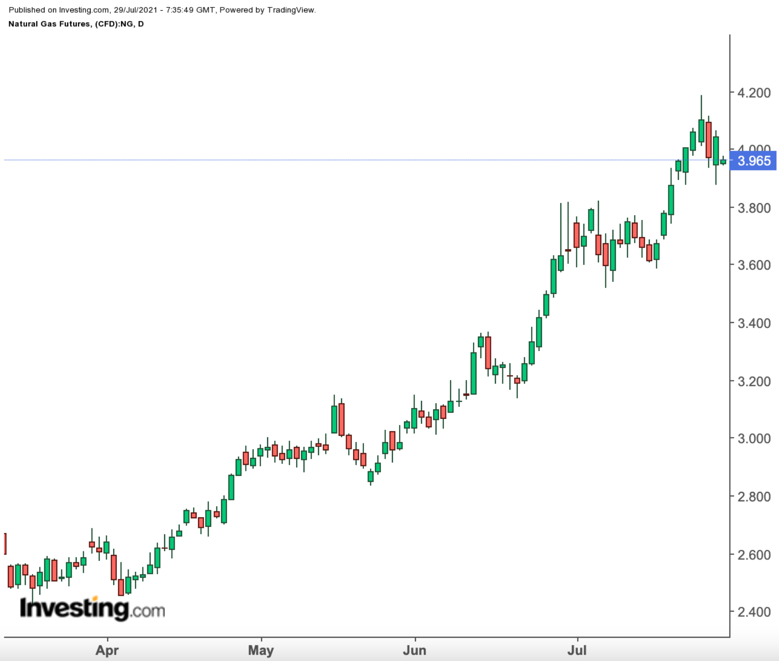With August beckoning, the long play in US natural gas has begun—not the game of buying and holding but rather the game of guessing when the summer heat will back off enough to allow more injection of gas into storage.

As those who trade this market know, the seven-week window to autumn is even shorter in terms of actual heat expectations. Therefore, figuring out air-conditioning demand, which is integral to the summer market for gas, is all important for traders.
The other challenge, of course, is predicting as accurately as possible what the opening stockpile for winter gas will be.
Dan Myers, analyst at Houston-based gas markets risk consultancy Gelber & Associates, laid it out to the firm’s clients in an email shared with Investing.com:
“As hot summer temperatures slowly ease off and weather-driven demand subsides, it is expected that in the following weeks, the size of the coming injections will begin to become larger in August.”
The debate over gas injections comes as the Energy Information Administration prepares to release its latest weekly update of the US natural gas storage situation at 10:30 AM ET (14:30 GMT) today.
It also comes a day after the expiry of the front-month August gas contract on NYMEX, which went off the board at $3.965 per mmBtu, or million metric British thermal units. On Tuesday, August hit $4.114, its highest since December 2018. Despite the outperformance, gas prices appear poised to end the week down 2%, marking their second weekly decline in 10.
According to forecasts from analysts tracked by Investing.com, US storage levels for natural gas had probably risen by 43 bcf, or billion cubic feet, during the week ended July 23.
If true, that would be 12% lower than the 49 bcf injected into storage in the previous week to July 16, ostensibly due to less burning of the fuel for cooling.
On an annual basis, the injection for the July 23 week is expected to be nearly 60% less than the 27 bcf seen during the same week a year ago. It would be similarly higher than the five-year (2016-2020) average of 28 bcf.
But more importantly, the injection for the July 23 week would only take total gas stockpiles in storage to 2.721 tcf, or trillion cubic feet. That would be 5.6% below the five-year average and 15.9% below the same week a year ago.
The lower amount of gas burned by utilities last week resulting in the higher injection into storage appeared to relate to temperature levels for last week.
Data provider Refinitiv said there were 87 CDDs, or cooling degree days last week, compared with the 30-year average of 90 CDDs.
CDDs, which are used to estimate demand to cool homes and businesses, measure the number of degrees a day's average temperature is above 65 degrees Fahrenheit or 18 degrees Celsius.
Forecaster NatGasWeather noted that more summer heat was expected to taper in the coming days.
“National demand will be much lighter this weekend and next week as a series of weather systems over Canada advance aggressively across the eastern half of the US with comfortable highs of 70s to mid-80s,” the firm said in a forecast carried by industry portal natgasintel.com.
Notwithstanding that, the forecaster projected that heat will intensify from August 6-11 as most of the Lower 48 states “warms back above normal with highs of mid-80s to 100s for a return to strong national demand.”
Cooler-than-average temperature anomalies also resulted in a lower-than-average week for LNG exports last week.
Despite that, US liquefied natural gas exports were holding strong this week at just shy of 11 bcf per day—a level near all-time highs, natgasintel.com reported.
LNG exports to fuel cooling needs in Asia and Europe are soaking up supply and feeding imbalance worries, the portal said. Estimates this week showed LNG production around 91 bcf, below recent highs and well below levels prior to the pandemic. The divergence between demand and output has provided price support for futures.
“We’re still in summer, exports are strong and production is pretty low,” Marex North America LLC’s Steve Blair, a senior account executive, was quoted as saying. “For what we are seeing, I think there’s a bullish undercurrent to this market that could last through the summer.”
Disclaimer: Barani Krishnan uses a range of views outside his own to bring diversity to his analysis of any market. For neutrality, he sometimes presents contrarian views and market variables. He does not hold a position in the commodities and securities he writes about.
Which stock should you buy in your very next trade?
AI computing powers are changing the stock market. Investing.com's ProPicks AI includes 6 winning stock portfolios chosen by our advanced AI. In 2024 alone, ProPicks AI identified 2 stocks that surged over 150%, 4 additional stocks that leaped over 30%, and 3 more that climbed over 25%. Which stock will be the next to soar?
Unlock ProPicks AI
